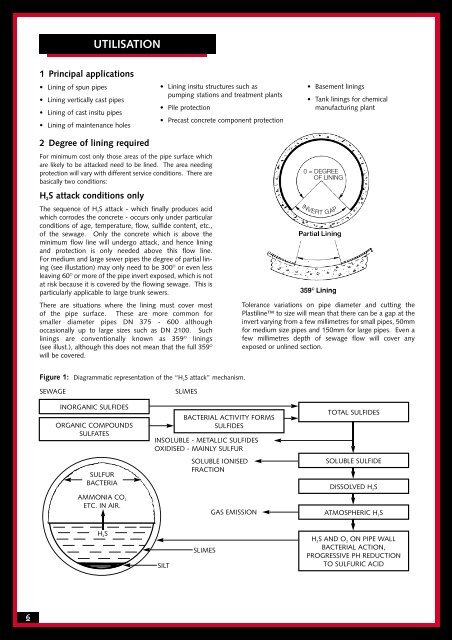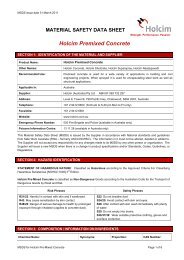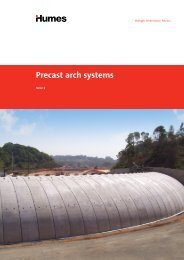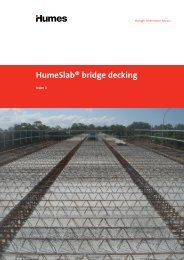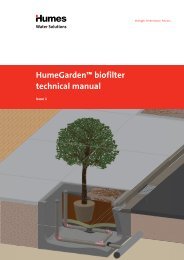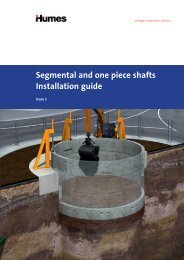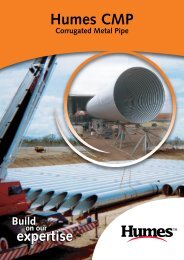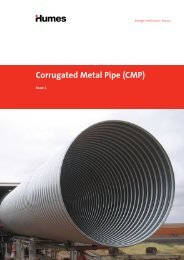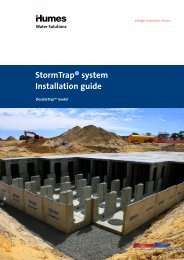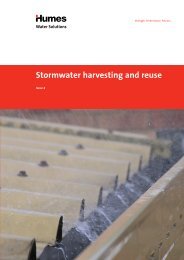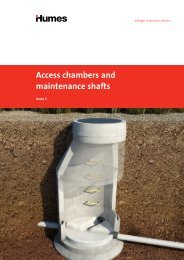Plastiline™ - Humes
Plastiline™ - Humes
Plastiline™ - Humes
You also want an ePaper? Increase the reach of your titles
YUMPU automatically turns print PDFs into web optimized ePapers that Google loves.
UTILISATION<br />
1 Principal applications<br />
• Lining of spun pipes<br />
• Lining vertically cast pipes<br />
• Lining of cast insitu pipes<br />
• Lining of maintenance holes<br />
• Lining insitu structures such as<br />
pumping stations and treatment plants<br />
• Pile protection<br />
• Precast concrete component protection<br />
• Basement linings<br />
• Tank linings for chemical<br />
manufacturing plant<br />
2 Degree of lining required<br />
For minimum cost only those areas of the pipe surface which<br />
are likely to be attacked need to be lined. The area needing<br />
protection will vary with different service conditions. There are<br />
basically two conditions:<br />
H 2 S attack conditions only<br />
The sequence of H 2 S attack - which finally produces acid<br />
which corrodes the concrete - occurs only under particular<br />
conditions of age, temperature, flow, sulfide content, etc.,<br />
of the sewage. Only the concrete which is above the<br />
minimum flow line will undergo attack, and hence lining<br />
and protection is only needed above this flow line.<br />
For medium and large sewer pipes the degree of partial lining<br />
(see illustation) may only need to be 300 O or even less<br />
leaving 60 O or more of the pipe invert exposed, which is not<br />
at risk because it is covered by the flowing sewage. This is<br />
particularly applicable to large trunk sewers.<br />
There are situations where the lining must cover most<br />
of the pipe surface. These are more common for<br />
smaller diameter pipes DN 375 - 600 although<br />
occasionally up to large sizes such as DN 2100. Such<br />
linings are conventionally known as 359 O linings<br />
(see illust.), although this does not mean that the full 359 O<br />
will be covered.<br />
0 = DEGREE<br />
OF LINING<br />
INVERT<br />
GAP<br />
Tolerance variations on pipe diameter and cutting the<br />
Plastiline to size will mean that there can be a gap at the<br />
invert varying from a few millimetres for small pipes, 50mm<br />
for medium size pipes and 150mm for large pipes. Even a<br />
few millimetres depth of sewage flow will cover any<br />
exposed or unlined section.<br />
Figure 1: Diagrammatic representation of the “H 2<br />
S attack” mechanism.<br />
SEWAGE<br />
INORGANIC SULFIDES<br />
ORGANIC COMPOUNDS<br />
SULFATES<br />
SULFUR<br />
BACTERIA<br />
AMMONIA CO 2<br />
ETC. IN AIR.<br />
SLIMES<br />
BACTERIAL ACTIVITY FORMS<br />
SULFIDES<br />
INSOLUBLE - METALLIC SULFIDES<br />
OXIDISED - MAINLY SULFUR<br />
SOLUBLE IONISED<br />
FRACTION<br />
GAS EMISSION<br />
TOTAL SULFIDES<br />
SOLUBLE SULFIDE<br />
DISSOLVED H 2 S<br />
ATMOSPHERIC H 2 S<br />
H 2 S<br />
SILT<br />
SLIMES<br />
H 2 S AND O 2 ON PIPE WALL<br />
BACTERIAL ACTION,<br />
PROGRESSIVE PH REDUCTION<br />
TO SULFURIC ACID<br />
6


